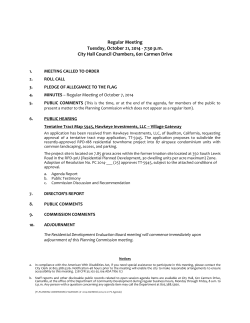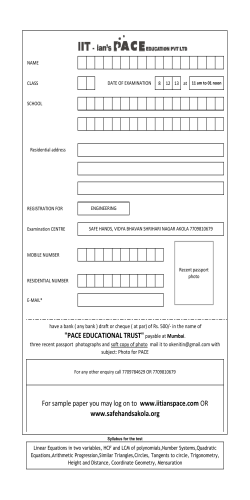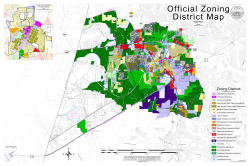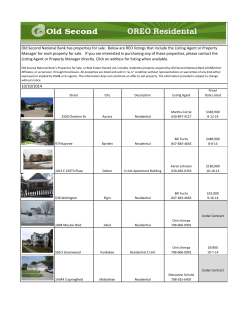
April 2008 Compensation, Reparation and Redress Laura Thomas, Lizzie Simpson & Enda O’Callaghan
Compensation, Reparation and Redress Laura Thomas, Lizzie Simpson & Enda O’Callaghan April 2008 © PIAC 2008 Overview • Introduction • Three compensation or reparation schemes: - Stolen Generations of Aboriginal Children Act (Tasmania) - Residential Institutions Redress Board (Ireland) - Indian Residential Schools Agreement (Canada) • Activity: design a redress scheme for victims of abuse in State care in NSW © PIAC 2008 Some common themes • Addressing historical wrongs • Perpetrated by government & churches • Particularly vulnerable victims • Alternative to litigation © PIAC 2008 Terminology • Compensation • Reparation: - acknowledgement & apology - guarantees against reptition - measures of restitution - measures of rehabilitation - monetary compensation • Redress © PIAC 2008 Background to the Tasmanian Scheme • 1995 -Aboriginal Lands Act • 1997 - Tasmanian Parliament apologised to the Stolen Generations of Tasmania • 2003 - Abuse in State Care Review Scheme • 2006 - Stolen Generations of Aboriginal Children Act 2006 • 2008 - announcement of a new Review Scheme © PIAC 2008 Eligibility Criteria - Category One Category One - Child/Ward of the State (section 5(1)): • Must be an Aboriginal person; • Must have been living on 16 October 2006; and • Must on or before 31 December 1975 have been admitted as a child of the State under the Infants’ Welfare Act 1935 or admitted or declared a ward of the State under the Child Welfare Act 1960; and • Must have remained a child or ward of the State for a continuous period of 12 months or more and must not have been in the care of an Aboriginal family during that period. © PIAC 2008 Eligibility Criteria -Category Two Category Two - Active Intervention of a State Government Agency (section 5(2)): • Must be an Aboriginal person; • Must have been living on 16 October 2006; and • Must have been removed from his/her family between 1935 and 1975 for a continuous period of 12 months or more; • Must not have been in the care of an Aboriginal family during that period; and © PIAC 2008 Eligibility Criteria - Category Two • Was removed by the active intervention of a State Agency; • Without the approval of a parent or guardian; or • Duress or undue influence was applied to bring about removal © PIAC 2008 Eligibility Criteria - Category Three Category Three - Descendants Claim (section 5(3)) • Must be an Aboriginal person; • Must be a living biological child of a deceased person who satisfies the criteria in subsection (1) or (2) © PIAC 2008 The Assessment Process Stolen Generations Assessment Process Applications Received Initial Reading undertaken by Assessor Further documentary evidence Initial Assessment Undertaken If criteria met If criteria not met Final Decision Interview with applicant Further advice sought © PIAC 2008 Final Decision Ireland Commission to Inquire into Child Abuse (known as the Laffoy Commission) Compensatory Advisory Committee (produced the Ryan Report) Residential Institutions Redress Board © PIAC 2008 The Residential Institutions Redress Board - Ireland HISTORIC BACKGROUND Mid 19th Century - British Government policy to remove children from families and place them in institutions. Policy continued locally after Irish independence. 1970s - The Kennedy Report leads to the abolition of the institutional system. 1990s - Survivors and victims of the institutions launch litigation and campaign for compensation. 1999 - ‘States of Fear’ broadcast. An Taoiseach Bertie Ahern apologises and commences legislative response. © PIAC 2008 The Residential Institutions Redress Board - Ireland “On behalf of the State and all the citizens of the State, the Government wishes to make a sincere and long overdue apology to the victims of childhood abuse for our collective failure to intervene, to detect their pain, to come to their rescue.” Taoiseach Bertie Ahern, 11 May 1999. © PIAC 2008 The Residential Institutions Redress Board - Ireland LITIGATION Statute of Limitations (Amendment) Act 2000 altered legislation retrospectively to facilitate litigation in the interests of justice. If person suffers psychological injury due to child abuse, they shall be deemed to be under a disability. Normal 3-year period of limitations not to commence until psychological injury overcome . Takes into account a tendency to delay reporting crime by victims of abuse/sexual crimes. Similar amendment in Australia would overcome the hurdles in Cubillo and Gunner. © PIAC 2008 The Residential Institutions Redress Board - Ireland THE COMMISSION TO INQUIRE INTO CHILD ABUSE (LAFFOY COMMISSION) Commission to Inquire into Child Abuse Act 2000. Commission to listen to people who have been abused during childhood in an institution tell their story. Commission to inquire into the abuse of children since 1940, find out why it occurred and who was responsible. Commission to report directly to the public on the results of the inquiry, any recommendations stemming from those results, what steps should be taken to deal with any continuing effects of abuse and what protections need to be put in place to prevent the abuse of children in State care from taking place now and in the future. © PIAC 2008 The Residential Institutions Redress Board - Ireland Four areas of abuse examined – neglect, physical, sexual and emotional abuse. Victims and survivors get a choice as to how they want to tell and record their story - a Confidential Committee or an Investigative Committee. Evidence taken on oath Failure to appear before or co-operate with Committees an offence. © PIAC 2008 The Residential Institutions Redress Board - Ireland Laffoy Commission - Confidential Committee For survivors who don’t want to be involved in investigative proceedings. Hearings to be held in private before two committee members, no crossexamination. Survivors may bring a person with them for support (reasonable costs of bringing a person in support to be met by scheme). Hearing may be audio recorded, but survivor can object to any recording. No-one the subject of an allegation at this committee will be named in a report. At the end of the process the committee will issue a general report on its findings, without naming survivors, perpetrators or institutions. © PIAC 2008 The Residential Institutions Redress Board - Ireland Laffoy Commission - Investigative Committee Full inquiry and investigation of allegations. Victims and survivors can produce evidence. Committee can test evidence and rule on cases of child abuse. Victims submit an initial application, an officer of the Committee investigates and any person or institution accused is notified of the hearing. Both victims and accused may be legally represented. Both victims and accused may be questioned on the evidence they provide. Committee can compel attendance of witnesses and production of documents. Committee to publish its findings at the completion of the process, naming institutions and responsible persons or managers of the institutions. © PIAC 2008 Laffoy Commission - applications to give evidence 31 Jul 01 Confidential Investigation Committee (1,192) Men Committee (1,957) Total (3,149) 650 1,406 2,056 542 551 1,093 301 440 741 378 670 1,048 (65%) Women (35%) 60 years of age or older (24%) Resident outside State (33%) © PIAC 2008 The Residential Institutions Redress Board - Ireland The Compensatory Advisory Committee (The Ryan Report) Devise a scheme that is fair and reasonable, provides individual assessment that is consistent with court awards in similar personal injury cases, or likely payouts from future court awards. Scheme to provide predictability, sensitivity and flexibility. © PIAC 2008 The Residential Institutions Redress Board - Ireland Compensatory Advisory Committee Scheme does not seek to put the injured person in the position in which they were prior to abuse taking place but to provide solace for victims in an attempt to put right a grave wrong. Awards can provide victims with tangible recognition of the serious hurt and injury caused. Providing redress can “allow many of those victims to pass the remainder of their years with a degree of physical and mental comfort which would otherwise not be readily obtainable” - The Ryan Report. © PIAC 2008 The Residential Institutions Redress Board - Ireland . Constitutive elements of redress Weighting © PIAC 2008 Severity of abuse 1-25 Severity of injury resulting from abuse Severity of injury resulting from abuse Severity of injury resulting from abuse Medically verified physical or psychiatric illness Psychosocial sequelae Loss of opportunity 1-30 1-30 1-15 The Residential Institutions Redress Board - Ireland Redress Total weighting for severity of abuse and injury/effects of abuse Award payable by way of redress V 70 or more €200,000 €300,000 IV 55-69 €150,000 €200,000 III 40-54 €100,000 – €150,000 II 25-39 €50,000 – €100,000 I Less than 25 Up to €50,000 . Band © PIAC 2008 Aus $1 = €0.60 The Residential Institutions Redress Board - Ireland Additional redress on the principle of aggravated damages Where the injury suffered by an applicant was not restricted to specific acts of abuse, but was exacerbated by the general climate of fear and oppression which pervaded the institution in which he or she was resident, additional redress may be awarded by the Board. Such additional award may not exceed 20% of the redress otherwise payable. An additional award based on the principle of aggravated damages will only be made where the Board is satisfied that the manner in which the applicant was abused was so oppressive or outrageous that an award based solely on the constitutive elements of redress does not represent an award which is fair and reasonable having regard to the unique circumstances of the applicant. No redress on the principle of punitive or exemplary damages. © PIAC 2008 The Residential Institutions Redress Board - Ireland The Residential Institutions Redress Board (RIRB) To compensate those who as children were victims of abuse while in the care of institutions and in respect of which State bodies had regulatory or supervisory functions. The Residential Institutions Redress Board (RIRB) is a wholly independent body chaired by a judge. 3-year application period: December 2002 to December 2005. 2,667 applications finalised in 2006. Scheme was widely advertised in the global press and specialist publications such as ‘Irish Echo’. Board officers travelled to the US and UK to hear evidence and take submissions. © PIAC 2008 The Residential Institutions Redress Board - Ireland Applicants to the Board must establish four matters in order to qualify for an award: his or her identity; his or her residence during childhood (under 18 years of age) in an institution listed in the schedule to the Act; he or she was abused while so resident and suffered injury, and that injury is consistent with any abuse alleged to have occurred while resident. © PIAC 2008 The Residential Institutions Redress Board - Ireland Abuse of a child means: the wilful, reckless or negligent infliction of physical injury on, or failure to prevent such injury to, the child; the use of the child by a person for sexual arousal or sexual gratification of that person or another person; failure to care for the child which results in serious impairment of the physical or mental health or development of the child or serious adverse effects on his or her behaviour or welfare, or any other act or omission towards the child which results in serious impairment of the physical or mental health or development of the child or serious adverse effects on his or her behaviour or welfare. © PIAC 2008 The Residential Institutions Redress Board - Ireland The Board does not make findings of fault or negligence. Applicants are not required to produce evidence of negligence by a person, their employer or a public body. Where there is a conflict of evidence, the making of an award to an applicant does not constitute a finding of fact or fault. The fact that applicants do not have to prove fault separates the RIRB redress scheme from litigation, where proof of negligence and fault is the key to success or failure. Applicants unhappy with a decision or non-decision to pay can ask for a review. The quantum of compensation offered can be appealed also. © PIAC 2008 The Residential Institutions Redress Board - Ireland Interim payments of 10,000 Euro are available depending on age and health of applicant (Aus$14,000). The highest level of compensation for the worst case scenario is Euro 300,000 (approximately Aus$480,000, almost equal to the only court determined compensation for a member of the Stolen Generation in which Mr Bruce Trevorrow was awarded $500,000 by the South Australian Supreme Court.) Applicants unhappy with a decision or non-decision to pay can seek review. The quantum of compensation offered can be appealed also. © PIAC 2008 The Residential Institutions Redress Board - Ireland . NATURE OF INJURY EXAMPLES PHYSICAL OR PSYCHIATRIC ILLNESS 1. Physical injury 2. Physical illness 1. Loss of sight or hearing. Loss of or damage to teeth. Permanent scar(s)/disfigurement. 2. Sexually transmitted diseases. Respiratory diseases. Skin diseases. 3. Psychiatric illness 3. Severe depression with suicide attempts. Personality disorder. Post-traumatic stress disorder. © PIAC 2008 The Residential Institutions Redress Board - Ireland PSYCHOLOGICAL . INJURY 1. Emotional disorder 2. Cognitive impairment/ educational retardation 3. Psychosocial maladjustment 4. Anti-social behaviour 1. Inability to show affection or trust. Low selfesteem; persistent feelings of shame or guilt. Recurrent nightmares or flashbacks. 2. Literacy level well below capability. Impoverished thought processes. Limited vocabulary leading to communication difficulties. 3. Marital difficulties involving sexual dysfunction. Low frustration tolerance. Shyness and withdrawal from mixing with people. 4. Substance abuse. Compulsive stealing. Physical aggressiveness. © PIAC 2008 The Residential Institutions Redress Board - Ireland . LOSS OF 1. Having to refuse OPPORTUNITY employment opportunity/ promotion because of illiteracy. 2. Need to concoct a false identity and to live a lie with workmates. 3. Unable to pursue certain occupations, e.g. police, because of “record”. © PIAC 2008 The Residential Institutions Redress Board - Ireland . TYPE OF ABUSE EXAMPLES SEXUAL ABUSE Violent anal or vaginal penetration. Victim made to masturbate member of staff or perform oral-genital acts. Sexual kissing; indecent touching of private parts over clothing. © PIAC 2008 The Residential Institutions Redress Board - Ireland .PHYSICAL ABUSE Serious injuries requiring hospitalisation; profound deafness caused by blows to ears. Severe beating causing e.g. a fractured limb or leaving permanent scars. Corporal punishment more severe than was legally sanctioned at the time, but leaving no permanent physical signs; Gross over-work involving inadequate rest, recreation and sleep. © PIAC 2008 The Residential Institutions Redress Board - Ireland . EMOTIONAL ABUSE Depersonalisation e.g. through family ties being severed without justification or through deprivation of affection. General climate of fear and apprehension. Stigmatisation by staff, e.g. through repeated racist remarks or hurtful references to parents © PIAC 2008 The Residential Institutions Redress Board - Ireland . NEGLECT Severe malnutrition; failure to protect child against abusive placements; inadequate guarding against dangerous equipment in work-place. Failure to provide legally prescribed minimum of school instruction; lack of appropriate vocational training and training in life skills. Inadequate clothing, bedding or heating. © PIAC 2008 Canada - Indian Residential Schools Historical context • Assimilation policy • Government and churches • 1874 to 1980s • Similar harms • 80,000 survivors © PIAC 2008 Canada - Indian Residential Schools More recent history: • More than 10,000 claims • Several large class actions • Focus on torts - physical and sexual assaults • Government Alternative Dispute Resolution © PIAC 2008 Indian Residential Schools Settlement Agreement Negotiation of Agreement: • May 2005 - Political Agreement between Canadian Government and Assembly of First Nations • Former Supreme Court Justice appointed to represent Canadian Government and facilitate negotiations • 6 month negotiation process •Canadian Government, Anglican, United, Presbyterian and Catholic Churches, AFN and other Indigenous organizations, lawyers for claimants • Settlement approved by 9 Canadian Courts © PIAC 2008 Indian Residential Schools Settlement Agreement • Common experience payments: $10,000 + $3000 for each year in Institutionalisation, at least $1.9 billion total • Independent assessment process: serious physical or sexual assault and other abuse that caused serious psychological harm. - $275,000 cap - $430,000 cap lost income - $15,000 future care - 15% costs • Right of review © PIAC 2008 Indian Residential Schools Settlement Agreement • Truth and Reconciliation Commission ($60 million, 5 year mandate) • Commemoration fund ($20 million) • Aboriginal Healing Fund ($125 million) © PIAC 2008 Indian Residential Schools Agreement • Total cost well in excess of $2 billion • Churches contributing: - $40 million for Common Experience Payments - in-kind support - contribution to payments under Independent Assessment Process depending on facts © PIAC 2008
© Copyright 2025










